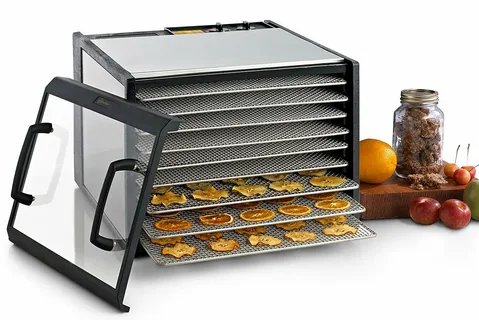Herbs and spices are the soul of culinary creativity, transforming everyday dishes into gourmet experiences. But have you ever considered preserving their vibrant flavours for future use? Dehydrating herbs and spices is a fantastic way to extend their shelf life while retaining all those aromatic qualities that make them essential in the kitchen.
With an Excalibur Food Dehydrator, this process becomes efficient and rewarding. Imagine filling your pantry with jars of dried basil, rosemary, and chilli flakes, ready to elevate any meal immediately. Whether you’re a seasoned chef or just starting your culinary journey, mastering the art of dehydration opens up endless possibilities for flavour enhancement and ingredient preservation. Ready to dive in? Let’s explore how to get started!
Choosing the Right Herbs and Spices for Dehydration
Selecting the right herbs and spices is crucial for successful dehydration. Freshness is essential, so opt for vibrant, undamaged leaves or whole spices without blemishes. Popular choices include basil, thyme, oregano, and rosemary. These herbs retain their flavour beautifully when dried. For a touch of heat, consider chilli peppers; they dehydrate well and pack a punch in dishes.
When it comes to spices like garlic and ginger, using them fresh enhances their potency once dried. Always remember that delicate herbs such as parsley or cilantro require careful attention to drying time to prevent brittleness. Personal preference plays a significant role, too. Think about which flavours inspire your cooking adventures. The best-dehydrated ingredients are those that will enrich meals with the familiar yet exciting tastes you love most.
Preparing Your Herbs and Spices: Cleaning and Prepping
Cleaning herbs and spices is a crucial step in the dehydration process. Freshness matters, so it’s essential to remove any dirt or residues. Gently rinse them under cool running water. After rinsing, dry them on a clean towel or paper towel. Excess moisture can hinder the drying process, leading to spoilage later.
Next comes the prepping stage. Remove any tough stems from herbs like rosemary and thyme. For larger leaves, such as basil or sage, consider tearing them into smaller pieces for quicker drying. Spices often require less preparation, but ensure they are debris-free before dehydrating. This attention to detail enhances flavour retention during storage and ensures that each dried herb maintains its aromatic qualities when cooking.
Cutting and Chopping for Even Drying
Achieving even drying requires careful cutting and chopping techniques. Uniform pieces ensure consistent moisture removal, preventing some herbs from over-drying while others remain soggy. Start with a sharp knife or herb scissors to maintain clean cuts. For leafy herbs, such as basil or mint, strip the leaves from the stems and stack them for slicing. Aim for uniform leaf sizes—this facilitates quicker evaporation.
Thin slices are ideal for spices like ginger or garlic. This enhances the surface area and accelerates the dehydration process. Chopping into small bits can also work well for robust herbs like rosemary or thyme; they dry more uniformly when reduced to similar sizes. Consistency is key here. Investing time in proper preparation pays off later with flavorful results that last longer in storage.
Setting Up Your Excalibur Food Dehydrator
Setting up your food dehydrator is a straightforward process that allows you to quickly start preserving your favourite fruits, vegetables, and herbs. The Excalibur is renowned for its efficiency and versatility, making it a popular choice among home food preservers. Here’s a quick guide to help you get started:
Unboxing and Assembly
Begin by carefully unboxing your Excalibur Food Dehydrators and ensuring all parts are present. This typically includes the central unit, trays, and possibly a mesh screen or tray liners. Place the dehydrator on a flat, stable surface to ensure proper airflow and functionality.
Cleaning before Use
Before using your Excalibur for the first time, it’s essential to clean it. Wash the trays and removable components with warm, soapy water and rinse thoroughly. Dry these parts completely before reassembling them. This step removes any dust or residues from manufacturing and ensures a clean environment for your food.
Setting up the Dehydrator
Assemble the dehydrator by inserting the trays into the central unit. Ensure they fit securely and are evenly spaced to allow optimal air circulation. If your model includes a temperature control knob or digital settings, adjust these according to the type of food you plan to dehydrate. The Excalibur usually has a guide for recommended temperatures and times for various foods.
Preheating the Unit
For best results, preheat the dehydrator for a few minutes before loading your food. This helps establish a consistent drying environment and can improve the quality of the final product.
With these steps, your food dehydrator will be ready for action, helping you create delicious, preserved foods with minimal effort.
Arranging Herbs and Spices on Dehydrator Trays
Arranging herbs and spices on the dehydrator trays is crucial for uniform drying. When placing items, ensure they are spread out in a single layer. Overcrowding can lead to uneven moisture retention. Grouping similar types not only makes it easier to monitor progress but also optimizes space utilization. Larger leaves like basil or kale may require more room than tiny thyme or oregano flakes.
Make sure that none of the pieces overlap. This allows air circulation, which is vital for effective dehydration. The Food Dehydrator features adjustable trays, giving flexibility based on different herb sizes. Consider using parchment paper for smaller bits that might fall through gaps in the trays. This simple step keeps everything contained while allowing airflow around each piece, ensuring an even drying process throughout your batch.
Adjusting Temperature Settings for Dehydration with Excalibur Food Dehydrators Australia
When dehydrating herbs and spices, temperature plays a crucial role in preserving flavor and nutrients. The Excalibur Food Dehydrators Australia offers precise temperature controls that make this task straightforward.For most leafy herbs, setting the dehydrator between 95°F and 115°F (35°C to 46°C) often yields the best results. This low range helps retain essential oils without cooking them away.
On the other hand, spices like garlic or onion can handle slightly higher temperatures of around 125°F (52°C). This ensures complete moisture removal while enhancing their flavours. Experimenting with these settings may be necessary based on personal preference or specific recipes. Always consult dehydration guidelines for individual herbs and spices for optimal outcomes. Adjustments might lead to delightful discoveries in taste and aroma during culinary adventures.
Monitoring Dehydration Progress
Monitoring dehydration progress is critical in ensuring that herbs and spices turn out perfectly. Regular checks allow for adjustments to be made as needed. Every type of herb has its unique drying time. Observing the colour, texture, and aroma during dehydration can provide valuable insights into readiness.
Using the Food Dehydrator simplifies this process with its transparent trays. This feature enables easy viewing without interrupting airflow or temperature settings. It’s essential to resist opening the dehydrator too often. Frequent checking can lead to heat loss and uneven drying results. Keep a close eye on moisture levels in each batch. A quick pinch test helps determine if herbs are sufficiently dried; they should crumble easily between fingers. Documenting these observations provides a reference for future drying sessions while perfecting timing for personal preferences.
Checking for Proper Dryness with Excalibur Food Dehydrator Australia
Determining the proper dryness of herbs and spices is crucial for preserving flavour and potency. With Excalibur Food Dehydrator Australia, this process becomes simple and efficient. Gently squeeze a few pieces between your fingers. Dried herbs should crumble easily without any moisture lingering. For spices, a quick visual inspection can reveal their readiness; they should appear brittle with no signs of elasticity.
Another effective method involves checking the aroma. A strong, concentrated scent indicates flavours preserved well during dehydration. If there’s little to no fragrance, further drying may be necessary. Keep in mind that different herbs require varying levels of dehydration time. Regularly monitoring progress ensures optimal results. Using Excalibur’s transparent trays allows for easy visibility throughout the process, making it easier to achieve perfectly dried ingredients every time.
Cooling and Storing Dehydrated Herbs and Spices
After the dehydration process is complete, it is essential to allow herbs and spices to cool down. This step helps preserve their vibrant colours and potent flavours. Place them on a clean countertop or a cooling rack. Ensure that air circulates freely around them for optimal cooling.
Once cooled, it’s time to store these treasures properly. Choose airtight containers like glass jars or vacuum-sealed bags to keep moisture at bay. Label each container with the date of dehydration and the herb or spice name for quick access later. Store in a dark, cool place away from direct sunlight to maintain freshness over time. Regular checks are recommended; ensuring no signs of moisture will keep dehydrated items flavorful longer. Proper storage can make all the difference in preserving those aromatic qualities that enhance culinary creations.
Testing for Freshness and Flavor
Ensuring freshness and flavour is crucial when it comes to enjoying high-quality food. Testing for these aspects is about evaluating taste and ensuring the ingredients are at their best. Here’s how you can effectively test for freshness and flavour:
Smell Test The first step in assessing freshness is the smell test. Fresh food should have a pleasant, natural aroma. For fruits and vegetables, a robust and fruity smell indicates ripeness. The item may be past its prime if there’s any sour, off, or musty odour.
Visual Inspection Next, inspect the appearance. Fresh produce should be vibrant in colour and free from blemishes or discolourations. For meats and seafood, look for transparent, moist surfaces and avoid anything slimy or discoloured.
Texture Check Texture is another key indicator. Fresh fruits and vegetables should feel firm and crisp. Meats should be tender but not mushy, and seafood should be resilient to the touch. A firm crust and soft, moist interior signify freshness for baked goods.
Taste Test Finally, the taste test is where flavour comes into play. Fresh ingredients should offer a robust, natural flavour. For example, a ripe tomato should taste sweet and tangy, while fresh herbs should burst with aromatic flavours.
By following these steps, you can ensure that your food is fresh and flavoured, enhancing your overall dining experience.
Conclusion
Dehydrating herbs and spices with the Excalibur Food Dehydrator elevates culinary experiences. This method captures vibrant flavours, ensuring freshness for months. Experimentation is key. Each herb or spice possesses unique drying times and requirements. Tailoring the process enhances results significantly. Storing dehydrated products in airtight containers prolongs their shelf life. An excellent, dark place will keep them flavorful and aromatic for longer. Enjoying home-dehydrated herbs opens up a world of creativity in cooking. It invites the exploration of new recipes while savouring familiar favourites infused with rich, concentrated tastes.
FAQS
What types of herbs and spices are best for dehydration?
Most herbs, such as basil, oregano, thyme, and parsley, dehydrate well. For spices, consider using dried chilli peppers or garlic. It’s important to choose fresh specimens without blemishes.
How long does it take to dehydrate herbs in an Excalibur Food Dehydrator?
Dehydrating times of Excalibur Food Dehydrator vary depending on the herb type and moisture content. Typically, herbs need about 1-4 hours at a low temperature.
Can the Food Dehydrator handle large batches of herbs?
It’s designed with multiple trays, allowing larger quantities to be dehydrated simultaneously while maintaining airflow for even drying.
Is there a specific temperature setting recommended for different types of herbs?
Generally, the Food Dehydrator should be set between 95°F 115°F (35°C and 46°C) for optimal results when dehydrating most culinary herbs.
How should dehydrated herbs be stored after cooling down?
To preserve their potency and flavour, store them in airtight containers away from light and heat. Glass jars or vacuum-sealed bags work great.
| Related Business Listings |
| Contact Directory |
| Local Business Profiles |

